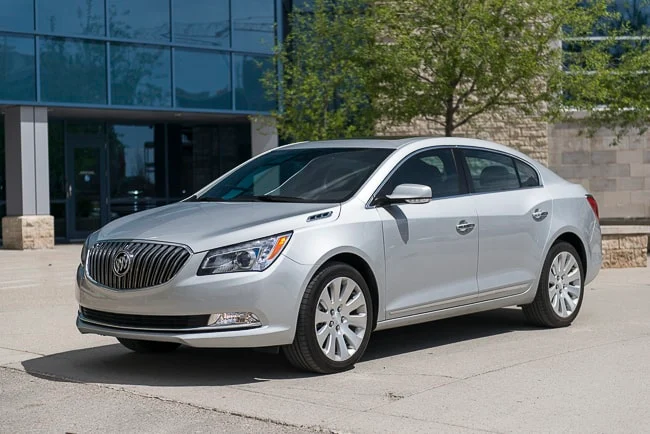Buick LaCrosse 2014 Owner’s Manual
The 2014 Buick LaCrosse is an elegant and classy full-size car that looks and feels very stylish. The LaCrosse is comfy and stylish to drive because it has a sleek exterior and a nice interior. It has roomy seats for up to five people and a nice interior with high-quality materials and the latest technology. The LaCrosse comes with an option of powerful and fuel-efficient engines that make driving smooth and quick. It also has a well-tuned suspension system that makes the ride smooth and comfy. The LaCrosse puts safety first and has a number of high-tech safety features, such as forward collision warning, lane departure warning, and blind-spot tracking. Overall, the 2014 Buick LaCrosse has style, comfort, and high-tech features that make it a great choice for people who want to drive in style and comfort.
Trailer Towing
General Towing Information
Only use towing equipment that has been designed for the vehicle. Contact your dealer or trailering dealer for assistance with preparing the vehicle for towing a trailer. Read the entire section before towing a trailer. For towing a disabled vehicle, see Towing the Vehicle on page 10-81. For towing the vehicle behind another vehicle such as a motor home, see Recreational Vehicle Towing on page 10-81.
Driving Characteristics and Towing Tips
Driving with a Trailer
When towing a trailer:
- Become familiar with the state and local laws that apply to trailer towing.
- Do not tow a trailer during the first 800 km (500 mi) to prevent damage to the engine, axle, or other parts.
- Then during the first 800 km
(500 mi) of trailer towing, do not drive over 80 km/h (50 mph) and do not make starts at full throttle. - Vehicles can tow in D (Drive). Shift the transmission to a lower gear if the transmission shifts too often under heavy loads and/or hilly conditions.
- Do not use Adaptive Cruise Control when towing.
- The Automatic Collision Preparation System should be set to Off when towing. See Active Emergency Braking System on page 9-52.
- Turn off Park Assist when towing.
Warning
When towing a trailer, exhaust gases may collect at the rear of the vehicle and enter if the liftgate, trunk/hatch, or rear-most window is open.
When towing a trailer:
- Do not drive with the liftgate, trunk/hatch, or rear-most window open.
- Fully open the air outlets on or under the instrument panel.
- Also adjust the climate control system to a setting that brings in only outside air. See “Climate Control Systems” in the Index.
For more information about Carbon Monoxide, see Engine Exhaust on page 9-26.
Towing a trailer requires a certain amount of experience. The combination you are driving is longer and not as responsive as the vehicle itself. Get acquainted with the handling and braking of the rig before setting out for the open road. Before starting, check all trailer hitch parts and attachments, safety chains, electrical connectors, lamps, tires, and mirrors. If the trailer has electric brakes, start the combination moving and then apply the trailer brake controller by hand to be sure the brakes work. During the trip, check occasionally to be sure that the load is secure and the lamps and any trailer brakes still work.
The following Distance
Stay at least twice as far behind the vehicle ahead as you would when driving the vehicle without a trailer. This can help to avoid heavy braking and sudden turns.
Passing
More passing distance is needed when towing a trailer. The combination will not accelerate as quickly and is longer so it is
necessary to go much farther beyond the passed vehicle before returning to the lane.
Backing Up
Hold the bottom of the steering wheel with one hand. To move the trailer to the left, move that hand to the left. To move the trailer to the right, move your hand to the right. Always back up slowly and,
if possible, have someone guide you.
- Making Turns
When turning with a trailer, make wider turns than normal. Do this so the trailer will not strike soft shoulders, curbs, road signs, trees, or other objects. Avoid jerky or sudden maneuvers. Signal well in advance.
If the trailer turn signal bulbs burn out, the arrows on the instrument cluster will still flash for turns. It is important to check occasionally to be sure the trailer bulbs are still working.
Driving on Grades
Reduce speed and shift to a lower gear before starting down a long or steep downgrade. If the transmission is not shifted down, the brakes might get hot and no longer work well.
Vehicles can tow in D (Drive). Shift the transmission to a lower gear if the transmission shifts too often under heavy loads and/or hilly conditions.
When towing at high altitude on steep uphill grades, consider the following: Engine coolant will boil at a lower temperature than at normal altitudes. If the engine is turned off immediately after towing at high altitude on steep uphill grades, the vehicle may show signs similar to engine overheating. To avoid this, let the engine run while parked, preferably on level ground, with the automatic transmission in P (Park) for a few minutes before turning the engine off. If the overheat warning comes on, see Engine Overheating on page 10-21.
Parking on Hills
Warning
Parking the vehicle on a hill with the trailer attached can be dangerous. If something goes wrong, the rig could start to move. People can be injured, and both the vehicle and the trailer can be damaged. When possible, always park the rig on a flat surface.
If parking the rig on a hill:
- Press the brake pedal, but do not shift into P (Park) yet. Turn the wheels into the curb if facing downhill or into traffic if facing uphill.
- Have someone place chocks under the trailer wheels.
- When the wheel chocks are in place, release the regular brakes until the chocks absorb the load.
- Reapply the brake pedal. Then apply the parking brake and shift into P (Park).
- Release the brake pedal.
Leaving After Parking on a Hill
- Apply and hold the brake pedal.
- Start the engine.
- Shift into a gear.
- Release the parking brake.
- Let up on the brake pedal.
- Drive slowly until the trailer is clear of the chocks.
- Stop and have someone pick up and store the chocks.
Maintenance when Trailer Towing
The vehicle needs service more often when pulling a trailer. See Maintenance Schedule on
page 11-2. Things that are especially important in trailer operation are automatic transmission fluid, engine oil, axle lubricant, belts, cooling system, and
brake system. It is a good idea to inspect these before and during the trip.
Check periodically to see that all hitch nuts and bolts are tight.
Trailer Towing (Except eAssist)
Before pulling a trailer, three important considerations have to do with weight:
- Weight of the trailer.
- Weight of the trailer tongue.
- Total weight on your vehicle’s tires.
Weight of the Trailer
How heavy can a trailer safely be? It should never weigh more than 454 kg (1,000 lb). But even that can be too heavy.
It depends on how the rig is used. For example, speed, altitude, road grades, outside temperature, and how much the vehicle is used to pull a trailer are all important. It can depend on any special equipment on the vehicle, and the amount of tongue weight the vehicle can carry.
See “Weight of the Trailer Tongue” later in this section.
Maximum trailer weight is calculated assuming only the driver is in the tow vehicle and it has all the required trailering equipment. The weight of additional optional equipment, passengers, and cargo in the tow vehicle must be subtracted from the maximum trailer weight.
Ask your dealer for trailering information or advice, or write us at our Customer Assistance Offices. See Customer Assistance Offices on page 13-3.
Weight of the Trailer Tongue
The tongue load (1) of any trailer is an important weight to measure because it affects the total gross weight of the vehicle. The Gross Vehicle Weight (GVW) includes the curb weight of the vehicle, any cargo carried in it, and the people who will be riding in the vehicle.
If there are a lot of options, equipment, passengers, or cargo in the vehicle, it will reduce the tongue weight the vehicle can carry, which will also reduce the trailer weight the vehicle can tow. If towing a trailer, the tongue load must be added to the GVW because the vehicle will be carrying that weight, too. See Vehicle Load Limits on page 9-10.
FAQ
A1: The 2014 Buick LaCrosse can accommodate up to five passengers.
A2: The 2014 Buick LaCrosse offers two engine options: a 2.4-liter four-cylinder engine and a 3.6-liter V6 engine.
A3: The fuel efficiency of the 2014 Buick LaCrosse varies depending on the engine and trim level, but it generally ranges from around 18 mpg in the city to 28 mpg on the highway.
A4: No, the 2014 Buick LaCrosse is only available with front-wheel drive.
A5: The 2014 Buick LaCrosse comes equipped with features such as antilock brakes, stability control, traction control, multiple airbags, and OnStar emergency communications system.
A6: The 2014 Buick LaCrosse comes with a six-speed automatic transmission.
A7: Yes, a rearview camera is a standard feature on the 2014 Buick LaCrosse.
A8: The 2014 Buick LaCrosse is available in several trim levels, including Base, Leather, Premium I, and Premium II.
A9: Yes, the 2014 Buick LaCrosse offers features such as a touchscreen infotainment system, Bluetooth connectivity, available navigation, and optional premium audio systems.
A10: Yes, heated seats are available as an option on certain trims of the 2014 Buick LaCrosse.
A11: Yes, a panoramic sunroof is available as an option on certain trims of the 2014 Buick LaCrosse.
A12: The 2014 Buick LaCrosse offers a trunk capacity of approximately 13.3 cubic feet.
A13: Yes, the 2014 Buick LaCrosse offers available safety features such as forward collision alert, lane departure warning, and blind-spot monitoring.
A14: Yes, the 2014 Buick LaCrosse comes with a basic warranty of 4 years/50,000 miles and a powertrain warranty of 6 years/70,000 miles.
A15: The 2014 Buick LaCrosse offers available luxury features such as leather upholstery, ventilated front seats, dual-zone automatic climate control, and a premium Bose sound system.
Useful Link
Download Link: https://www.buick.com/support/vehicle/manuals-guides


